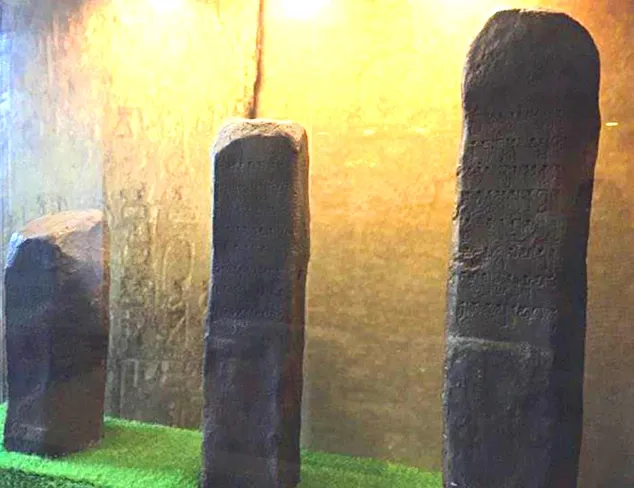 |
| Yupa inscriptions in Borneo |
Yupa inscriptions in Borneo
Kalimantan, the third largest island in the world, is also known as the world's lungs because it stores carbon reserves. The island that God created while smiling seems to be endless to mention and write about the beauty and charm of nature. humans and civilization.
It is not surprising that Indonesia made Kalimantan (East Kalimantan to be precise, where the Hindu-Indian kingdom was founded in the 4th and 5th centuries AD from a local king, Kudungga) as the country's capital which is known as Ibu Kota Nusantara (IKN).
Read Borneo As A Choice Of Ecotourism And Historical Tourism Destinations
This is due to the historical factor that the East Kalimantan region is a source of civilization, as evidenced by the Yupa stone inscriptions.
Did literacy, which we are pursuing and living today, suddenly come? Without a past horizon?
No! Don't we know that there is a dimension of time: past, present, and future. What is today can become the past. The future, is now. Which is now? Honestly, there is no "now". If we say "this second", then the time has passed a fraction of a second from when the word "now" was spoken. Tempus fugit [1]. Time is running!
As an activist, as well as a worker, literacy. I feel obligated to visit historical sites in Kalimantan. Not why. Direct visit to the locus, will open the eyes of our hearts. To be able to "feel" the atmosphere of the past, when the events called "history" occurred.
What makes an event, or a human act, worth "history"?
That's the question that tempts me. So much so, that several times (not satisfied with just once), I visited the Mulawarman Museum, in Kutai, this. I then understood: in what is called history there was a "leap of civilization." In it, involving a community in the direction of an increasingly civilized change, not just progress. And the ADAB is universal.
That is what Yupa's inscription chronicles. In my heart, I am endlessly grateful.
Luckily there is a Yupa inscription. If not. Forever we never understand. That Borneo has triumphed since the end of the 4th century AD, or the middle of the first millennium.
Yupa literally means: stone pillar. In fact, the Yupa inscription is not just one. There are a total of 7 chunks.
Read Ulu Aik Kingdom | A Call For Dayak Historical Literacy
Written in pallawa script. While the language used is Sanskrit. From a paleographical study conducted by Kern (1917), it is known. That the script used to write the Yupa inscription has similarities with the typology of the Wengi script in Kalingga and the Cera script in Merkara. Both are regions located in South India.
Well, this is where the relative date of the Yupa inscription comes from. Which is suspected in the IV century AD.
This news and information channel. Is also an inscription, like Yupa stone. Why is that? Think about it yourself.
Luckily there is a Yupa inscription. The Yupa I inscription reads thus:
srimatah sri-narendrasya; kundungasya
mahatmanah; putro svavarmmo vikhyatah;
vansakartta yathansuman; tasya putra
mahatmanah; trayas traya ivagnayah; tesan
trayanam pravarah; tapo-bala-damanvitah;
sri mulavarmma rajendro; yastva
bahusuvarnnakam; tasya yajnasya yupo
'yam; dvijendrais samprakalpitah .
Translation:
The Emperor Kudungga, who is very
noble, has a famous son,
Sang Aswawarman by name, who
like Angsuman (Sun god)
raised a very noble family.
The Aswawarman had three sons,
like (holy) fire.
The most prominent of the three sons is
Sang Mulawarman, a well-civilized, strong, and powerful king. Sang Mulawarman
has held a feast (called a feast) of gold-a lot. This stone monument was erected by the brahmins to commemorate the feast (salvation) .
Fortunately, there is a Yupa inscription. Indisputable historical evidence. Small thing, but recorded throughout all centuries. Kudungga is suspected to be a native of Borneo. He is the ancestor of the Dayak tribe. It is a proof that the natives of Borneo (Varuna dvipa in Indian Hindu literature), have been able and have a sophisticated organization, to regulate social and community life. Has had a high civilization in his time.
Read One Billion Hill: Pepper Gardens In The Interior Of West Kalimantan
It could be that the designers of the Yupa inscriptions thought far ahead. Because as sharp as human collective memory is, far sharper is the opaque ink/writing.
Not unlike the initiators and founders of the news and information channel that you are currently reading. Is also an inscription, like Yupa stone.
Capture, as well as narrate, Borneo today. Which, thousands of years down the road, must be immensely valuable!
Pampang Cultural House, East Kalimantan
With hermeneutic efforts, people, thousands of years into the future. Will understand Borneo, and Indonesia, through the digital footprint presented in each menu.
(continued)
[1] The term “tempus fugit” appears in line 284 of Virgil's book 3 which describes that time ( tempus ) is running on and on, unable to return, let alone be reproduced. Published around 29 BC, the poem is called a "alam desa" nuance, a nature poem . In English, Georgic. That is a poem or book dealing with agricultural or rural topics, which usually glorify outdoor work and the simple rural life. It often takes the form of didactic or instructive poetry intended to give instruction relating to a skill or art.
[2] Muara Kaman is now a sub-district in the center of Kutai Kertanegara Regency, East Kalimantan. In the past, this area was the center of the royal government which lasted since Kudungga and was enlarged and made fresh by Mulawarman. Past history still leaves its mark here, where there is a large long black stone called the locals "Lesong Batu", which is believed to have been the material for sculpting or making the Yupa inscription, which is now originally kept at the National Museum, Jakarta.












